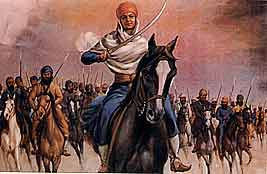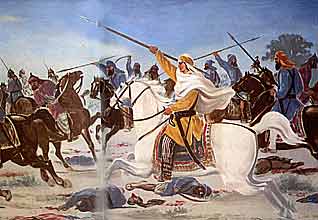
The forty deserters from Anandpur lived in the Majha region in the district of Amritsar. In one of their villages, called Jhabal, there lived a brave woman named Mai Bhago. She was known for her faith and courage, and she had a great zeal to serve the Guru. Her blood boiled at the timidity of those who, beaten by the ravages of the prolonged siege of Anandpur, disclaimed Guru Gobind Singh Ji to return to their homes. She was smitten at the ignominy shown by these forty deserters. Mai Bhago charged them with cowardice and lack of faith. She was determined to wipe out this stain of infamy on Majha Singhs. She went around the neighbouring villages and exhorted the women folk not to be hospitable to the deserters who had disclaimed the Guru. She shamed and censured the Singhs for their cowardice and eventually brought them back to the path of devotion and sacrifice. She, donning a man's dress, inspired them to return to the fold of Guru Gobind Singh ii. Feeling ashamed for their act of cowardice, they followed her banner and joined in the famous battle of Muktsar, which was fought against the Mughal forces at Khidrana in the district of Ferozepur.

Mal Bhago followed Guru Gobind Singh Ji to Nander. After the Guru left the earthly abode in October 1708, she settled at Bidar, about 200 kilo-metres from Nander. There she lived at Gurdwara Nanak Ihira. Finally, she returned to Abchalnagar, Nander, where she died at a ripe old age. She is considered a saint by the Sikhs. The spear that she used in the battle of Muktsar is still preserved at Takht Sri Hazur Saheb, Nander.
(Article courtesy Dr. Santokh Singh, "The Guru's Word")